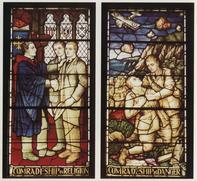Community Debate
Once the school had taken possession of its new premises, it once again became the centre of a debate by the Queenstown community.

Many of the pupils' parents, particularly the professional people, wanted it to be graded a first-class establishment which, while raising the tone of the school, would mean more cost to the town; others objected to higher school fees and wanted more emphasis placed on educating the poorer children.
The Lesseyton Collegiate School was established in 1871 by the Wesleyan (Methodist) Church; the Queenstown Collegiate School was a revival of the Prospect House school originated by Mr and Mrs Ham; and even St Michael's Church Grammar School was restarted, in a small hall adjoining the church. For children whose parents were too poor to pay the private fees, meanwhile, there was for a time Mrs Wiper's 'ticket-a-week' school: those who could afford it paid three pence a week, while the very poor of the town paid nothing at all.
In response to this competition, the management of Mr Beswick's school was handed over to the municipal council which, in 1874, succeeded in getting the school graded first class. The struggling Queenstown Collegiate School merged with Beswick's public school in 1880, and was renamed Queenstown High School. By 1881 the school could boast 139 boys and 88 girls. Head boy Herbert Everitt recalled in the school magazine of 1923 that the boys and girls worked together on opposite sides of the classroom.
Many Amalgamations
There were lean years to come for Mr Beswick's school, however. There were heated public debates about the system by which the management committee was elected, as a result of which some members of staff resigned and some parents decided to withdraw their children from the school.
Others chose to go it alone: a committee of the Wesleyan Church bought ground in Grey Street and built a hall to house a Wesleyan Grammar School for Boys that lasted for 20 years, until its union with the boys' high school in 1902; a Wesleyan High School for Girls was also opened, but struggled financially and for reasons of economy soon had to move into the boys' grammar school building. When the 1902 amalgamation took place, the girls' department became the Queenswood School for Girls, which has since closed down and been demolished.
Queen's College had not seen the last of its many amalgamations, however, in 1899 it was decided that for practical and financial reasons the Queenstown Boys' School and the Wesleyan Grammar School should join forces. Once again, therefore, the public school gained strength from union.
Herbert Wilkinson had taught on the staff of the Wesleyan-inspired Kingswood College in Grahamstown before moving to Queenstown to become principal of the grammar school there. In 1904, when Mr Clark's ill health forced his retirement, Mr Wilkinson became principal of the boys' high school, and was to remain in that position for a memorable period of 25 years. It was under Mr Wilkinson that much of the tradition and status of the school was established.
On his appointment as principal, Wilkinson inherited a new boarding establishment (today's Whitson House, renamed after an honorary life president of the Old Boys' Association), the first of several under his supervision which were to make Queen's College the largest boarding school in the country.